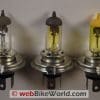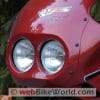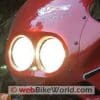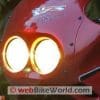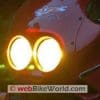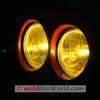There are many wonderful and unique things to do and to see in France.
One of the most curious for me was the use of the very distinctive yellow headlights on cars in France about 20 years ago or so.
They looked so…different.
Every once and a while, a car with yellow headlights will pass by on a European road; however, it’s my understanding that yellow lights are no longer legal in France or anywhere in Europe, except for auxiliary fog lights.
But European drivers and motorcyclists will always bend the rules, just like we do here in the U.S.A.
Aand using yellow headlights is one way to look different…
I never really knew why the cars in France had yellow headlights, but I’m told that yellow bulbs can provide better visibility in poor weather because they provide greater contrast.
Although yellow headlights are virtually non-existent in the U.S.A., daytime running lights (DRL’s), which were originally intended to make a car more visible, have become very common over the last decade or so.
DRL’s are also mandatory in Canada, Denmark, Finland, Hungary, Iceland, Norway, and Sweden (from the Insurance Institute for Highway Safety).
Some states in the U.S.A. also require the headlights to be on during poor weather conditions or whenever the windshield wipers are used during a rain storm.
There is some debate as to the effectiveness of DRLs in making vehicles more visible to other traffic.
DRLs are supposed to increase conspicuity, but if every vehicle has headlights burning, any one vehicle with headlights on may no longer be as conspicuous.
It’s like saying that by painting a car the “safety orange” color, it will be more visible to others. But if all cars were painted safety orange, then what?
For our purposes as motorcyclists, that argument is irrelevant. What interests us is the conspicuity or visibility of our motorcycles to other vehicles sharing the road.
Since daytime running lights are now legal in the U.S.A. and other parts of the world, one of the few methods we had to make ourselves more distinctive — using our headlights whilst riding — is nowhere near as effective, because so many other vehicles are doing the same.
We have many articles related to motorcycle lighting, visibility and conspicuity posted on webBikeWorld.
Please take a look at the webBikeWorld review article index and the motorcycle light reviews for reviews and articles on motorcycle brake lights, LED lighting, headlight modulators and more, all of which can help improve conspicuity and visibility.
This article is just one of a series of continuing studies on improving motorcycle visibility.
We make no claims as to the scientific accuracy of any of the articles. This is purely subjective information and our opinions on various products that might help.
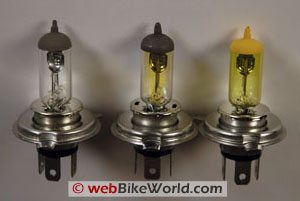
Can Yellow Headlights Make a Difference?
In a sea of daytime running lights, SUV’s, cell phones, in-dash GPS and DVD systems and all of the other madness and chaos on the roads today, a motorcyclist must use every trick and technique possible to stand out from the crowd.
Bright orange or yellow helmets work very well, and are at a location high enough to make a difference.
Unfortunately, those colors (especially bright orange) are not very popular for helmets. Bright motorcycle clothing and lighting may also make a difference.
I’ve always had those yellow French headlights in the back of my mind, and recently decided to see if I could locate a set and try some experiments in motorcycle lighting to see if they would make a motorcycle stand out from the crowd.
Although yellow may not be the best color for ultimate headlight visibility, I postulate that the color is different enough from normal “white” headlights that it will help make a motorcycle more conspicuous.
This is especially important for oncoming traffic.
The famous Hurt Study, the results of which are still valid, indicated that one of the most frequent causes of motorcycle accidents is when an oncoming vehicle turns left in front of a motorcycle because the driver didn’t notice it.
There have been some unscientific studies that I’ve read over the years that correlate vehicle size with conspicuity.
In other words, a small motorcycle, even with headlights blazing, has a small cross section which causes oncoming vehicles to grossly misjudge the speed and distance of the oncoming bike, and the bike appears much farther away than it really is.
Brightness and Dazzling
One other aspect of the issue of motorcycle headlights and conspicuity to consider is the brightness of the headlights.
Some motorcyclists use high beams during the day, and I’ve noticed many cruisers with a three-headlight light bar where the outside lights are deliberately pointed at oncoming traffic.
I’m of the opinion that this is very annoying to oncoming drivers and the brightness of the lights may actually cause the motorcycle to actually be less visible.
This is because the bulk of the motorcycle can sometimes “disappear” behind the dazzling brightness of the headlights.
Also, the dazzling bright lights may prevent the oncoming driver from noticing the motorcycle’s directional lights.
Motorcycle directionals are usually wimpy little 20 Watt bulbs behind a couple of square inches of yellow plastic, and they can be easily be lost in the dazzle caused by the motorcycle’s high beam.
The dazzling bright headlights can most definitely distort the ability to determine the motorcycle’s speed and distance to the oncoming vehicle.
That’s why I almost never use the high beams when riding a motorcycle during the daytime. I also do not modulate the high beam when using a headlight modulator, and I will only use modulators that have the ability to modulate the low beam.
It is my contention that it isn’t so much the ultimate power of the light but the quality that makes a difference.
Which brings us back to the yellow headlight bulbs. The emphasis lately seems to be towards bulbs providing “whiter” light, such as Xenon gas filled or HID lighting.
Light “color” is measured in Kelvin “temperature”, although the K value can be very misleading and is not very meaningful for actual light output.
The so-called “whiter” bulbs have something like a 3000°K to 4000°K color temperature, whilst some of the HID bulbs can get up to 5400°K, which is nearly equivalent to the color of sunlight on a sunny day around noon (5500°K).
Since I never go with the crowd, my desire was to go in the opposite direction, down to around 2000°K to 2500°K, about the same color as candlelight.
The popularity of customizing cars and motorcycles has opened up lots of options for anyone wishing to experiment with lighting, making it fairly easy to find bulbs of all different color temperatures and types.
Colored bulbs are also available; that is, bulbs with special coatings on the glass that provide various intensities color saturation that enhance or change the actual color temperature of the bulb itself.
One of the claimed benefits of yellow headlights is better perception in fog or misty weather. I found yellow bulbs in the standard 60/55W output that is most common (and legal) in the U.S.A.
However, since the yellow light seems to be “dimmer” than the white light, I decided to jump one level in power and go for the 80/70W versions.
Since anything over about 80W or so greatly increases the probability of problems with the motorcycle’s electrical system and with the possible melting of the plastic lens and reflector, bulbs above 80W should be avoided.
Also, the yellow bulbs are not legal in the U.S., and cranking them up to 110W or so probably would make the motorcycle just that much more of a target for ambitious law enforcement.
Yellow Light Bulbs for Motorcycle Use
I didn’t want to spend a fortune on this experiment, and I found two different bulb types to try. One is the Hella “Yellowstar” bulb, claimed to have a 2500°K color temperature.
These are available in the standard 60/55W and also in 80/70W, 110/85W and 130/90W. I purchased the 80/70W bulbs from Rally Lights, a Hella retailer, for $10.18 each.
When lit, the bulbs seem to have the same level of perceived brightness as the original equipment “white” 60/55W H4’s in the Triumph Tiger that we used for our trials.
I also purchased a pair of Nokya Hyper Yellow Pro Halogen bulbs from Automotive Lighting USA for $22.99 the pair. These have a 2500°K bulb plus a strong yellow coating on the glass.
The bulbs are advertised as 80/70W and the box they came in claims the same, but the metal base on each bulb is stamped “60/55W”.
We contacted Automotive Lighting USA about this discrepancy; they wrote back: “Many of the bulbs Nokya uses have the same bases to cut down on manufacturing costs.
The bulbs you received are 70/80w bulbs as shown on the package.
The 55/60w engraved on the base of the bulbs is just a standard Nokya base used for other lights. The bulbs you receive are the Wattage shown on the package.”
Hmmmm…I wonder.
The point is that there is much confusion and obfuscation in the world of headlight bulbs with regards to output claims, like the “55W bulbs with a 100W output”, so be careful.
I’m not saying that Nokya is deceitful, but it’s sure hard to tell when the base is stamped with a different output number than the box.
For the record, my experience with both Rally Lights and Automotive Lighting USA is very positive, as both companies answered all my questions prior to the sale and shipped the products immediately.
The Hella bulbs were damaged twice in shipment, and Rally Lights immediately sent another pair without question and didn’t even require sending back the damaged bulbs for proof.
Automotive Lighting USA has a large selection of bulbs of many different types and from many different manufacturers, and they answered my pre-sale questions and shipment was immediate.
Comparison of H4 Standard and Yellow Bulb Colors
Changing the bulbs on the Tiger is relatively easy, because the bulbs can be accessed by reaching up under the fairing without having to remove any parts.
However, we discovered that it’s very difficult to take photographs that do justice to the color temperature of the light bulbs.
The differences, while dramatic to the human observer, are not that apparent in the photos.
 |
 |
| Headlights off. | Photo 2: Stock “white” 60/55W H4 bulbs. |
|---|---|
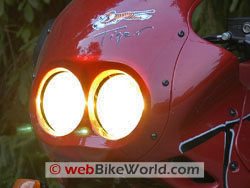 |
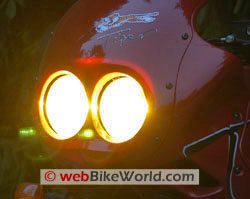 |
| Photo 3: Hella Yellowstar 80/70W H4 | Photo 4: Nokya Hyper Yellow 60/55W H4 |
The “yellowness” of the light is apparent, but hard to differentiate, in the photos. We tried several different locations, distances, focal lengths, shutter speeds, etc., but these seemed to be the best we could get.
We also tried taking photos in bright daylight at a distance of several hundred feet, but the results also didn’t really show the difference well enough to include here.
So, you’ll have to take my word for it! Photo 2 shows the original equipment, 60/55W “white” halogen lights.
They appear slightly yellow in the photo, which is normal, and is apparent if you’ve ever seen the difference between standard automotive lights and the “blue white” HID lights now available in some cars.
Photo 3 shows the Hella Yellowstar bulbs. You can see in the reflection on the fairing surrounding the light that there is a slightly more yellow cast. But the difference shown here is about the same as it is when viewing them “live”.
The Yellowstars are slightly more yellow, but they don’t have the dramatic difference I was searching for.
When taken out of the package, the Hella bulbs have a slight yellow tint, but the clear glass housing around the filaments looks clear.
Photo 4 shows the Nokya Hyper Yellow bulbs. These bulbs have some type of yellow coating on the clear glass housing around the filaments. Apparently, this helps to give the bulbs their very yellow cast.
The difference is not that apparent in the photos above, but a faster shutter speed demonstrates this difference in Photo 5 below:
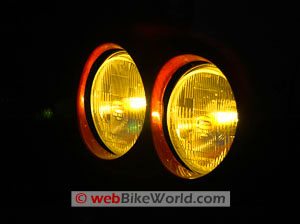
Conclusion
I am pleased with the outcome of this very unscientific experiment. The Nokya bulbs have a very yellow and very distinctive color, and many people have commented on them, so they must be doing their job.
Until someone conducts proper testing and analysis, the issue of visibility will be purely conjecture, but my opinion is that these bulbs will definitely make a motorcycle stand out from the crowd.
It remains to be seen how long the Nokya bulbs will last during the stresses experienced with motorcycle use. We’re also planning to install a headlight modulator on this bike with these bulbs, so stay tuned!
Publication Date: June 2005
Owner Comments and Feedback
See details on submitting comments.
From “S.P.” (March 2012): “I note the comment ‘There is some debate as to the effectiveness of DRLs in making vehicles more visible to other traffic.
DRLs are supposed to increase conspicuity, but if every vehicle has headlights burning, any one vehicle with headlights on may no longer be as conspicuous.’
I think the research proves the effectiveness of DRL (Daytime Running Light) use, and worry that we confuse the issue when we suggest motorcyclists “disappear” when cars run DRLs.
Like many, I drive cars and ride bikes, and I believe the only survival tactic is to assume other drivers do NOT see my bike. Yes, I try and be conspicuous with additional lights, Hyperlite brake lights, reflective panels and bright clothing.
But I never assume a driver sees me (or anything else, for that matter).
But consider the following situation. You are riding on a two-lane road late in the day, the sun is setting and shining directly at you.
Maybe there is a bit of grime on your visor. Wouldn’t you prefer the oncoming cars and trucks to have some DRLs? Because otherwise, they will be invisible.
That’s one important thing people forget about DRLs. They may not make you safer, but they make the other (idiots 🙂 safer for you.
I grew up in Canada (where DRLs are now mandatory on cars and bikes), lived in the US for years (some cars have DRLs, some don’t) and then moved to the UK.
When I arrived in the UK, there was not even a law that motorcycles had to have headlights on in the day, and when the EU forced the UK to comply, there were protests by bikers over their loss of “freedom”
Now that there is talk of DRLs on UK cars (Scandinavian countries already mandate them) they trot out the “we’ll lose our conspicuity!” argument. Sigh.
You really can’t rely on other drivers.
I recall riding in the rain on the Autobahn, going 80 – 90 mph, and being scared ***tless every so often as some silver Porsche or Audi went by at 120 mph with no lights on.
The law is they have to be on, but just because you can afford a nice, fast car doesn’t make you a better driver, or bring motorcyclists back from the dead. Please, give them all DRLs.
BTW – I am in France fairly often and still see older cars with yellow lights. I think the law is that newer cars have to meet EU “white light” standards but older ones are grandfathered.
Of course, the origin of the yellow lights was simply so the French could spot foreigners (true).
I see a lot of bikes in South Africa running orange lights. As in not yellow, but orange, using filters (i.e. reducing light) in front of the headlamp. They are all either BMWs or KTMs. A fad, I suspect. And they probably don’t ride at night in the rain
I always say, I like to ride at night and I don’t mind riding in the rain, but when it starts to rain when I am riding at night, I start looking for a motel.”
From “M.M.” (03/11): “Regarding your article on yellow headlights I wanted to add a few comments: 1. It is not illegal to run yellow headlights in California (here’s the law). Yet another reason why our state is the best place to ride a motorcycle in the world.
2. An alternative to yellow H4 headlight bulbs is to put a selective yellow balloon onto them. It’s said that more light is transmitted by running a good H4 bulb with a yellow balloon on it than running a yellow bulb.
3. I just replaced the poorly-designed stock 7″ DOT headlight assembly on my 2010 Triumph Thruxton with a 7″ Cibié e-code headlight with Narva 60/55W RangePower+50 H4 bulb and selective yellow balloon.
The selective yellow balloon will not fit over the OEM 60/55W Osram H4 bulb that comes on the Thrux.
The e-code light pattern is much more focused than the inferior DOT design and the light appears brighter where you want it. The yellow makes me stand-out and the definition is greater.
Even the little rain grooves in the freeway seem to pop out at night rather than being washed-out.
4. Daniel Stern Lighting has a very good article on the benefits of selective yellow light
5. Rode home last night from my first long ride at night since upgrading my headlight and ran into a slight bit of rain. It was amazing how everything in the rain looked so much more defined with the selective yellow light. It’s hard to explain. You just have to experience it.”
From “B.A.” (6/10): “Several years ago, I was hit by a car at an intersection while riding my H-D Heritage. It was a daylight accident and the driver said he just didn’t see me. Even at a low speed, it hurts a lot when you fall off a motorcycle.
After that, I changed the “passing lamps” to yellow sealed beams (4415-A’s), and I think it improved my visibility to oncoming traffic.
Now, since I ride my Harley to work in Houston (weather permitting), I swapped the stock headlamp bulb to a Nokya Hyper Yellow 60/55W H4 — about $20 for two.
Wow!
The bright yellow headlamp is really noticed, both day and night, by all vehicles in front of me — especially those attempting to turn into my lane from a side street or driveway.
So, is a yellow motorcycle headlight legal in Texas? Probably not.
If I’m stopped by a cop for the yellow headlight, I’ll try to talk my way out of it by suggesting that my Harley is a “European” model, and show him that my speedometer is in kilometers per hour (0 to 220) (It’s actually a Canadian model that I purchased new in Saudi Arabia and shipped back to Texas).
But, if your only hesitation about having a yellow headlight is getting a traffic ticket, you may want to re-examine your priorities. What’s more important, getting killed or paying a fine?
If I could, I’d light up my Harley like a carnival ride to improve my visibility to other vehicles.”
From “P.M.” (2/10): “I run HONDA PS-250 scooters (have three of them) and use the YELLOW H-4 bulbs in the stock pair of headlights. I also have a third headlight (a Hella Compact 4000 that I converted to HID.
Since I use yellow in the standard headlights I use a white HID (not brilliant white, but halogen shade of white) in it.
The contrast between the driving light on top and the 2 yellow headlights is outstanding. I get favorable comments all the time.
My alternator is a stock one that is 400 watts at 5000 rpm. I wish more scooters used high wattage alternators. Most motorcycle and scooter spec sheets don’t even list their outputs because they a pathetic. No reason for it either.
It was the main reason I bought and collect the PS-250 scooters. They should make 35-35 watt H-4 bulbs in yellow xenon. Be a lot safer out there.
Also: Forgot to mention the H4 Yellow bulbs I found use Xenon gas in the bulb too.
Going to install a pair in my 2001 Honda Odyssey van too. I like to add small white driving lights when running yellow in the headlamps. Contrast is the best way to get the attention of oncoming drivers.
On the scooter I installed turning lights, too. When I turn on the turn signal the marker on that side goes off and starts the flashing.
I use the + from the marker light to hold a relay then when it goes off the relay drops off and the NO contact becomes hot turning on the light for that side. It takes to relays with NO contacts to make the system work.
There are two turning lights. I use PIAA 004 lights as turning lights . It’s enough to light up the normally dark area I’m turning into at night. Going to add a second pair of lights on the rear of the scooter facing the front at 45° to the sides.
I also tilt them upwards slightly as the bike leans it brings the light level.
Exit ramps off expressways are less scary now. I’ve seen deer on ramps in the past and came up with this design to increase my margin of safety. Before it was driving into the dark on exit ramps. Quite scary sometimes.”
From “K.S.W.” (1/10): “I’ve been using PIAA Ion crystal bulbs in my headlights for some time now. Currently I ride a Honda Rune with a two bulb headlight, one for low beam and one for High Beam.
I replaced the low beam bulb with the “yellow” Ion Crystal bulb and run that in combination with the high beam during the day and night.
I’ve adjusted the high beam so as to not be a problem at night if you’re concerned. During bad weather, especially fog, I turn off the high beam and run only the yellow low beam.
Another advantage to the wavelength of the yellow or in my case Ion Crystal is that it shows moisture, ice, better than a standard bulb. This is why previously all fog lights where yellow in color.”
From “J.K.” (2/09): “Thank you for the great article. I thought I would add the following based on my own experience with the product which attempts to achieve a similar goal, without the cons of pure yellow bulbs and the resultant loss of lighting efficiency at night (I ride in all weather and day and night).
I use the Rainbow Strobe inserts (at Custom Dynamics; works with H4 bulbs only) which fit over any standard bulb, providing a rainbow coloring to the on-coming traffic without decreasing the light output of the bulb itself.”
From “M.P.” (2/09): “After reading your article, I too, replaced the stock bulb on my ’07 Triumph Bonneville last summer with the Nokya Hyper Yellow from Automotive Lighting.
I’m always looking for ways to make my ride safer & found that the effect of this was immediate & welcome.
People comment all the time on it & say that it really makes the bike stand out in traffic, especially on a cloudy day.
It also adds a cool, period look look to the Bonnie that makes folks think the bike is restored, even though it’s certainly not. Unintended – but hey, I’ll take it!
“R.M.”s response (below) on this subject was fascinating to me. He knows more about this than I knew existed! I almost never ride at night & I probably wouldn’t have made the switch if I regularly did.
One observation; when do I ride at night on low beam, it’s OK for speeds <50mph, & I feel safe. On high beam, however, the light pattern is scattered all over the place & up in the trees. Not good.
All in all, I’d highly recommend it if your riding is limited to daylight hours or only urban areas at night.”
From “R.M.” (10/08): “First off, thank you for the interesting and in depth commentary that is posted on webBikeWorld.com.
I found the article on “Improving Visibility with Yellow Bulbs” interesting and never thought of the idea of slightly “tainting” headlight color in order to make a motorcyclist stand out amongst other vehicles.
I think that there might be more to it than simply making a contrasting color to the average white hue of an automobile’s lamps.
Although you cite that there isn’t any quantitative data to support the use of yellow beams and its effect on motorcyclist’s safety, there is some data that can be drawn from visible light’s Luminous Efficiency and its relation to color.
For a given output power of, say, a 55 watt lamp, the human eye will perceive a varied intensity based not only on the power output of the lamp but also on the wavelength (aka color) of the visible light being emitted.
This is know was the Luminosity Efficiency Function (link to Wikipedia.)
The interesting thing is that the peak wavelength/color for perceived intensity is different for night and day vision because your eye uses different receptors to collect the visible light at different conditions.
That is to say one color will seem brightest during night vision and another color will seem brightest during day vision even though the actual power output of the lamp hasn’t changed.
The brightest appearing color for daylight is at a wavelength of 555 nanometers which relates to a greenish yellow (true yellow: 570 nm true green: 530nm) It’s no surprise that high visibility clothing that some motorcyclist use is this yellow/green color.
The brightest appearing color during night vision is 510 nm which correlates to a greenish blue (see the spectrum and efficiency chart [the green curve is night vision efficiency while the black curve is daylight. Note the y scale is loss (.1 = 10% efficient)].)
This is suggesting that by the use of yellow headlamps, a motorcyclist is not only differentiating themselves from automobiles but also projecting the best perceived (brightest) wavelength of light in an effort to be as visible as possible during daylight driving.
However, motorcyclist don’t only right during daylight conditions. Daylight vision, called Photopic vision (Wiki) uses the cones in the eyes to collect the visible light which also allows the perception of color.
Night vision, called Scotopic vision (Wiki) utilizes rods to collect the visible light (or lack of) and losses the ability to perceive color.
Now, we all know that we can still tell a red Ducati from a green Kawasaki when we speed around at night on a motorway but that is because the level of light intensity must be seriously low to be in the range of scotopic vision.
Page 2 of this article by Sylvania gives a great correlation of levels of darkness to the “luminance” (cd/m^2) level and the associated vision modes.
What is probably of most interest to us is that there is an area of mixed rod/cone use called Mesopic vision (Wiki.) This mixed rod/cone use allows some perception of color, particularly blues.
Many automobile headlights (HID, Xenon) already use this principle to create a bluish cast of light for the most efficient color of light to light up the road ahead and this would apply to motorcyclist also. And this correlates to the fact that the highest efficiency wavelength for night vision is 510nm.
What hurts the argument for yellow headlamps is the fact that pure yellow (570nm) is only about 40-50% efficient during pure night vision conditions.
It is probably a higher level of efficiency since most riding conditions are with mesopic vision but it shows that while yellow headlamps are likely the best option for daylight visibility, they hurt the ability of the motorcyclist to see what their headlight is illuminating at night on a dark road.
They would still provide the contrast that is important in traffic where driver’s eyes are in the mesopic region and can perceive colors and that might be what some riders are looking for.
But for riders who tend to ride in dark, rural areas with low levels of street lighting, this might be a concern and a yellow light might only be perceived as farther away and dimmer than a standard white hue.
The author countered the fact of lower illumination intensity at night with the use of a higher output bulb and that is certainly a good solution for both light conditions.
I bet the yellow shows like like crazy during the day to oncoming traffic and might even be to the level of a white hue high beam during the day while not over blinding at night. Another idea might be a mixed use of colors.
Although you’d like a overzealous fan of a sports team whose colors are yellow and blue, a combination of yellow and blue bulbs could be the best of both worlds for day visibility to other drivers while maintaining or enhancing night illumination.”
From “M.C.”: “… I have done a much simpler survey of the effects of yellow front lights on getting noticed. Several years ago I had a H-D FLH with the stock tractor light bar and a replacement Hella headlight.
I had installed a 55/100W bulb prior to any other work. The tractor light bar refers to the type of lights they installed on the light bar.
There was a corner near my home that I could bet you my pink slip (certificate of ownership) a car would pull out in front of me if one was at the entrance/exit from the shopping center onto the highway.
Now my FLH had the fairing and presented no small frontal area. Fortunately, I had one of the 4″ lights go out.
In researching what was available, I found that 4″ was a common size for spot lights. I resisted the urge to get a blue and a red light (all sealed beam) as the gendarmes would get the wrong idea for sure (yes Virginia, I would be noticed).
But I decided to try the yellow, as I figured that I might be seen better in the fog (I lived along the Central California coast at the time — tough place to live with a motorcycle), if nowhere else. ALL the difference in the world!
Where before I could guarantee a car would pull out in front of me, now I could make the opposite bet as long as I had the light bar on. The headlight and/or the clear light bar lights made no difference, but the yellow did. Today almost all vehicles on the road have halogen lamps for headlights.
When you see a vehicle with a yellow set of headlights, you notice it (even if it’s just sub-conscious), and that’s just the old cars, not the yellow that this article references.
I would suggest showing the effects in doing the light bars on cruisers separate from the headlights as well.”



